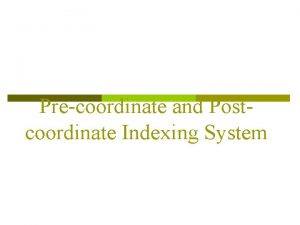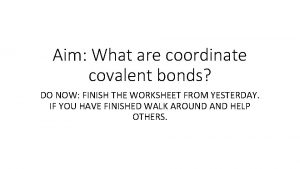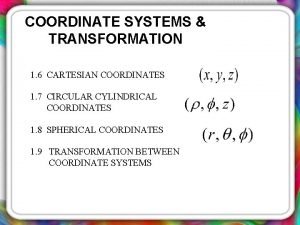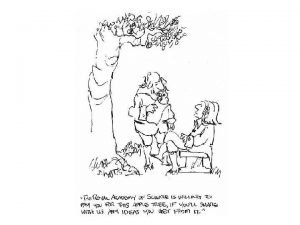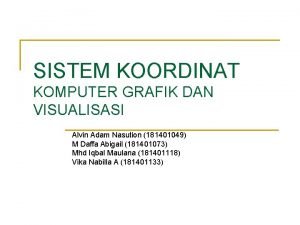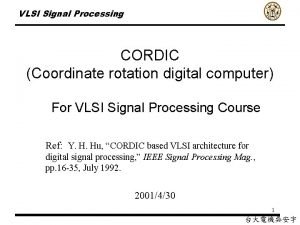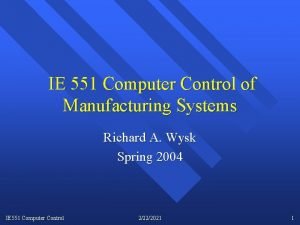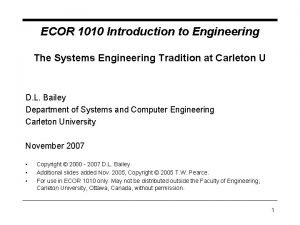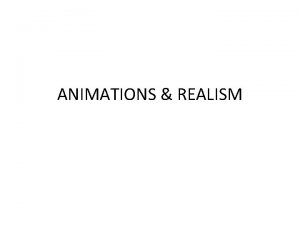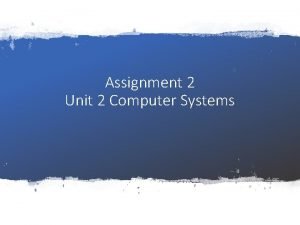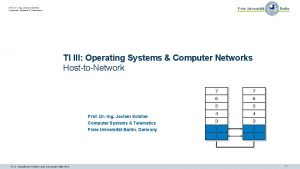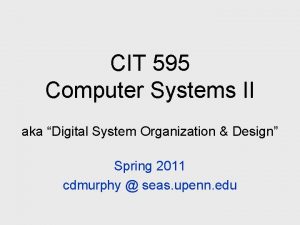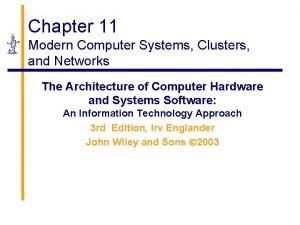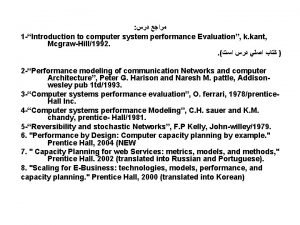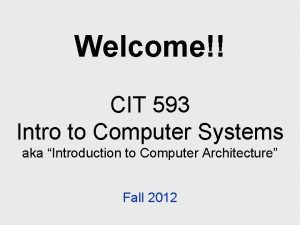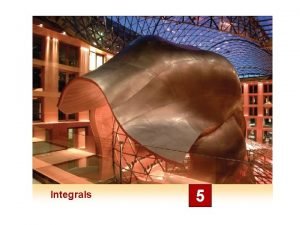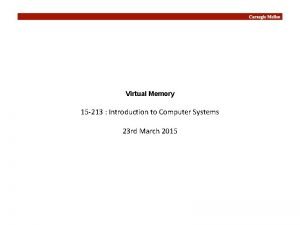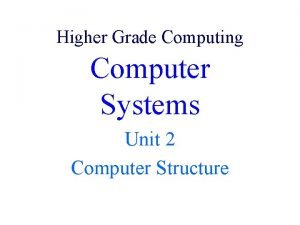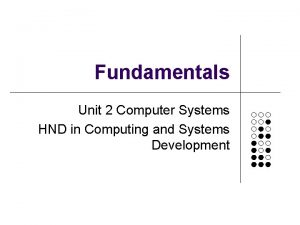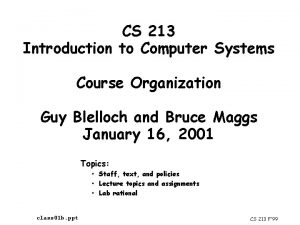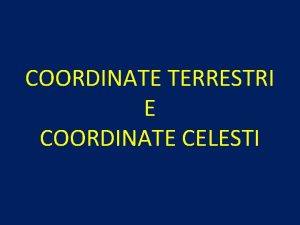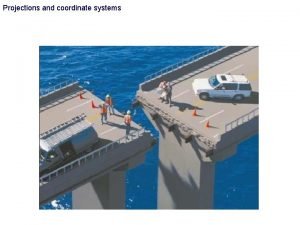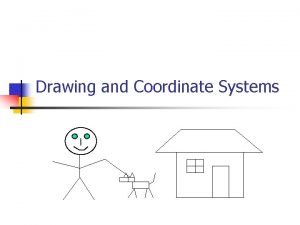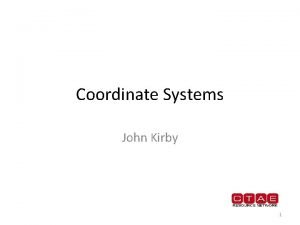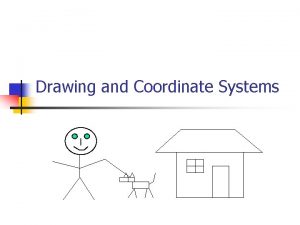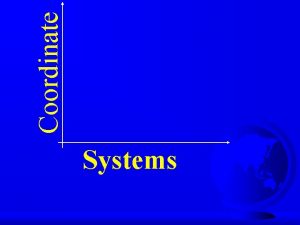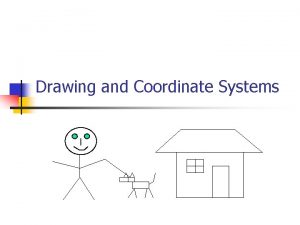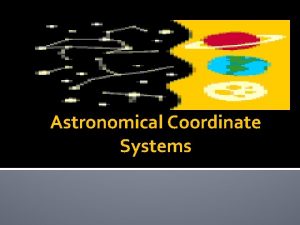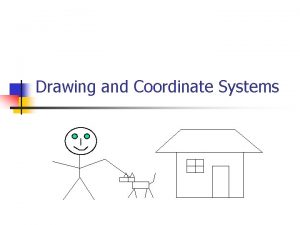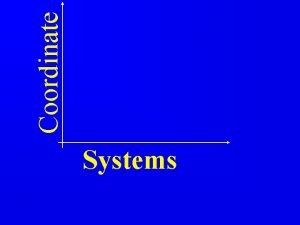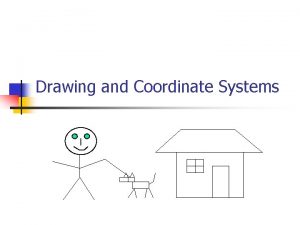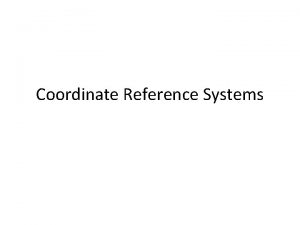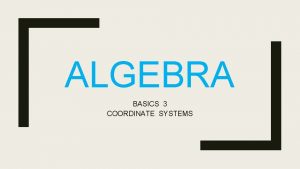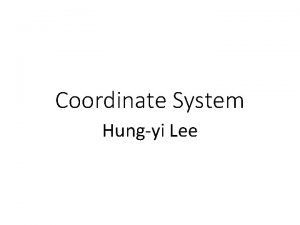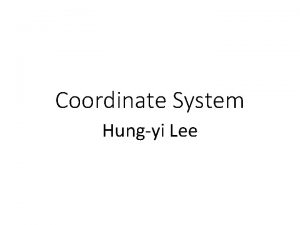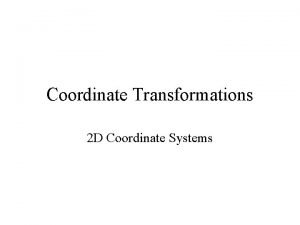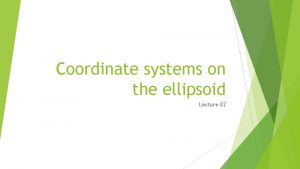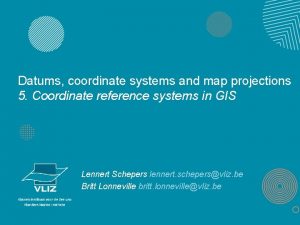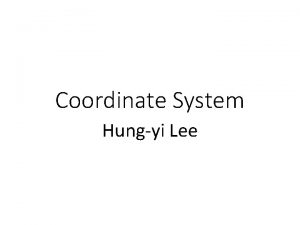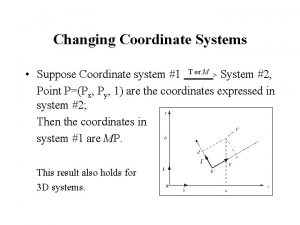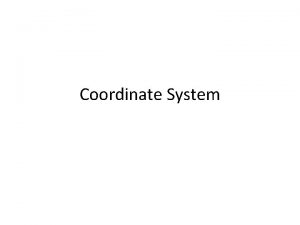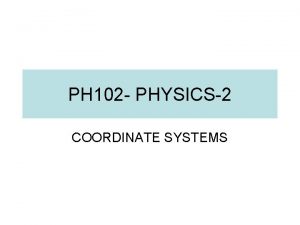3 D Coordinate Systems o 3 D computer
























![Rotation about an Arbitrary Axis o Multiplying [TR]AB by the point matrix of the Rotation about an Arbitrary Axis o Multiplying [TR]AB by the point matrix of the](https://slidetodoc.com/presentation_image_h/14a47b0d783958a4bf491ce3f17dc5e0/image-25.jpg)









- Slides: 34

3 D Coordinate Systems o 3 D computer graphics involves the additional dimension of depth, allowing more realistic representations of 3 D objects in the real world o There are two possible ways of “attaching” the Z-axis, which gives rise to a left-handed or a right-handed system

3 D Transformation o The translation, scaling and rotation transformations used for 2 D can be extended to three dimensions o In 3 D, each transformation is represented by a 4 x 4 matrix o Using homogeneous coordinates it is possible to represent each type of transformation in a matrix form and integrate transformations into one matrix o To apply transformations, simply multiply matrices, also easier in hardware and software implementation o Homogeneous coordinates can represent directions o Homogeneous coordinates also allow for non-affine transformations, e. g. , perspective projection

Homogeneous Coordinates o In 2 D, use three numbers to represent a point o (x, y) = (wx, wy, w) for any constant w 0 o To go backwards, divide by w, (x, y) becomes (x, y, 1) o Transformation can now be done with matrix multiplication

Basic 2 D Transformations o Translation: o Scaling: o Rotation:

Translation and Scalling Matrice o The translation and scaling transformations may be represented in 3 D as follows: Translation matrix Scaling matrix 1 0 0 0 ( 0 1 0 SX 0 0 0 SY 0 0 0 SZ 0 0 0 ( ) ) tr. X tr. Y tr. Z 1 0 0 0 1

Translation original V=(ai + bj +ck) == (a, b, c) translation along y, or V = (0, k, 0)

Scaling Original scale all axes scale Y axis offset from origin

3 D Shearing: The change in each coordinate is a linear combination of all three Transforms a cube into a general parallelepiped

Rotation o In 2 D, rotation is about a point o In 3 D, rotation is about a vector, which can be done through rotations about x, y or z axes o Positive rotations are anti-clockwise, negative rotations are clockwise, when looking down a positive axis towards the origin y y x x x z y z z

Major Axis Rotation Matrices o about X axis o about Y axis o about Z axis Rotations are orthogonal matrices, preserving distances and angles.

Rotation rotation of 45 o about the Z axis offset from origin translation then rotate about Z axis

Rotation Axis o In general rotation vector does not pass through origin

Rotation about an Arbitrary Axis o Rotation about an Arbitrary Axis Basic Idea y T (x 2, y 2, z 2) R (x 1, y 1, z 1) x z R-1 T-1 1. Translate (x 1, y 1, z 1) to the origin 2. Rotate (x’ 2, y’ 2, z’ 2) on to the z axis 3. Rotate the object around the z-axis 4. Rotate the axis to the original orientation 5. Translate the rotation axis to the original position

Rotation about an Arbitrary Axis o Step 1. Translation y (x 2, y 2, z 2) (x 1, y 1, z 1) x z

Rotation about an Arbitrary Axis o Step 2. Establish y (0, b, c) Projected Point (a, b, c) x z Rotated Point

Rotation about an Arbitrary Axis o Step 3. Rotate about y axis by y (a, b, c) Projected Point l d x (a, 0, d) z Rotated Point

Rotation about an Arbitrary Axis o Step 4. Rotate about z axis by the desired angle y l z x

Rotation about an Arbitrary Axis o Step 5. Apply the reverse transformation to place the axis back in its initial position y l l z x

Rotation about an Arbitrary Axis Find the new coordinates of a unit cube 90º-rotated about an axis defined by its endpoints A(2, 1, 0) and B(3, 3, 1).

Rotation about an Arbitrary Axis o Step 1. Translate point A (2, 1, 0) to the origin y B’(1, 2, 1) A’(0, 0, 0) z x

Rotation about an Arbitrary Axis o Step 2. Rotate axis A’B’ about the x axis by and angle , until it lies on the xz plane. y Projected point (0, 2, 1) z B’(1, 2, 1) l x B”(1, 0, 5)

Rotation about an Arbitrary Axis o Step 3. Rotate axis A’B’’ about the y axis by and angle , until it coincides with the z axis. y (0, 0, 6) l x B”(1, 0, 5) z

Rotation about an Arbitrary Axis o Step 4. Rotate the cube 90° about the z axis Finally, the concatenated rotation matrix about the arbitrary axis AB becomes,

Rotation about an Arbitrary Axis
![Rotation about an Arbitrary Axis o Multiplying TRAB by the point matrix of the Rotation about an Arbitrary Axis o Multiplying [TR]AB by the point matrix of the](https://slidetodoc.com/presentation_image_h/14a47b0d783958a4bf491ce3f17dc5e0/image-25.jpg)
Rotation about an Arbitrary Axis o Multiplying [TR]AB by the point matrix of the original cube

Rotation about an Arbitrary Axis o Reflection Relative to the xy Plane y y z z x o Z-axis Shear x

Q 1 - Translate by <1, 1, 1> o A translation by an offset (tx, ty, tz) is achieved using the following matrix: o So to translate by a vector (1, 1, 1), the matrix is simply:

Q 2 - Rotate by 45 degrees about x axis o So to rotate by 45 degrees about the x-axis, we use the following matrix:

Q 3 - Rotate by 45 about axis <1, 1, 1> o So a rotation by 45 degrees about <1, 1, 1> can be achieved by a few succesive rotations about the major axes. Which can be represented as a single composite transformation nx = 1 ny = 1 SO nz = 1

Q 3 - Arbitrary Axis Rotation o The composite transformation can then be obtained as follows: = ? ? x y z

Directions vs. Points o We have looked at transforming points o Directions are also important in graphics o Viewing directions o Normal vectors o Ray directions (1, 1) (-2, -1) o Directions are represented by vectors, like points, and can be transformed, but not like points o Say we define a direction as the difference of two points: d=a–b. This represents the direction of the line between two points o Now we translate the points by the same amount: a’=a+t, b’=b+t o Have we transformed d?

Homogeneous Directions o Translation does not affect directions! o Homogeneous coordinates give us a clear way of handling this, e. g. , direction (x, y) becomes homogeneous direction (x, y, 0), and remains the same after translation: o (x, y, 0) is a vector, (x, y, 1) is a point. o The same applies to rotation and scaling, e. g. , scaling changes the length of vector, but not direction o Normal vectors are slightly different though (can’t always use the matrix for points to transform the normal vector)

Alternative Rotations o Specify the rotation axis and the angle (Open. GL method) o Euler angles: Specify how much to rotate about X, then how much about Y, then how much about o These are hard to think about, and hard to compose o Quaternions o 4 -vector related to axis and angle, unit magnitude, e. g. , rotation about axis (nx, ny, nz) by angle : o Only normalized quaternions represent rotations, but you can normalize them just like vectors, so it isn’t a problem o But we don’t want to learn all the maths about quaternions in this module, because we have to learn how to create a basic application before trying to make rotation faster

Open. GL Transformations o Open. GL internally stores two matrices that control viewing of the scene o The GL_MODELVIEW matrix for modelling and world to view transformations o The GL_PROJECTION matrix captures the view to canonical conversion o Mapping from canonical view volume into window space is through a gl. Viewport function call o Matrix calls, such as gl. Rotate, gl. Translate, gl. Scale right multiply the transformation matrix M with the current matrix C (e. g. , identity matrix initially), resulting in CM - the last one is the first applied
 Pre and post coordinate indexing system
Pre and post coordinate indexing system Is co a covalent bond
Is co a covalent bond Differential surface area in cylindrical coordinates
Differential surface area in cylindrical coordinates Rotating coordinate systems
Rotating coordinate systems Screen coordinate
Screen coordinate Coordinate rotation digital computer
Coordinate rotation digital computer Decision support systems and intelligent systems
Decision support systems and intelligent systems Dicapine
Dicapine Embedded systems vs cyber physical systems
Embedded systems vs cyber physical systems Elegant systems
Elegant systems Computer control of manufacturing systems
Computer control of manufacturing systems Ecor 1010
Ecor 1010 Dedicated computers
Dedicated computers Distributed system in computer network
Distributed system in computer network What is motion specification in computer graphics
What is motion specification in computer graphics Computer systems unit
Computer systems unit In css nc ii, avr stands for
In css nc ii, avr stands for Unit 2 computer systems assignment 1
Unit 2 computer systems assignment 1 The protection of information in computer systems
The protection of information in computer systems What are the advantages of computerized accounting
What are the advantages of computerized accounting Computer assisted guidance systems
Computer assisted guidance systems Computer systems
Computer systems Cs 1104 final exam
Cs 1104 final exam Cit 595 upenn
Cit 595 upenn Computer systems components
Computer systems components Computer performance evaluation
Computer performance evaluation Cit 593
Cit 593 Integration using tables and computer algebra systems
Integration using tables and computer algebra systems 15-213 introduction to computer systems
15-213 introduction to computer systems Btec level 3 unit 2 computer systems assignments
Btec level 3 unit 2 computer systems assignments Unit 2 computer architecture answers
Unit 2 computer architecture answers Unit 2 computer systems
Unit 2 computer systems 15-213 introduction to computer systems
15-213 introduction to computer systems Define components of computer
Define components of computer What is computer organization
What is computer organization
